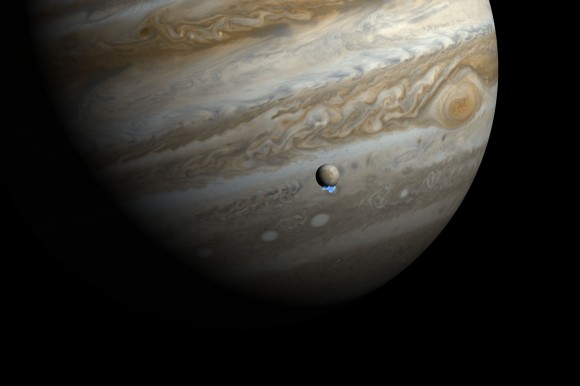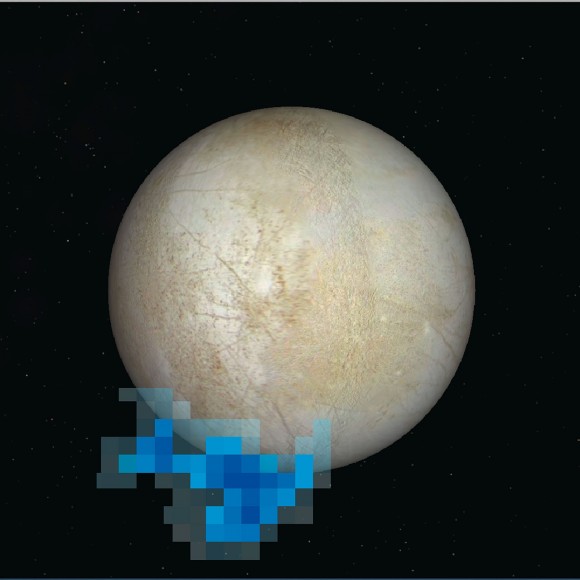Science
Related: About this forumHubble Discovers Water Plumes Erupting from Europa

UV observations from Hubble show the size of water vapor plumes coming from Europa’s south pole (Artist’s impression. Credit: NASA, ESA, and M. Kornmesser)
It’s been known since 2005 that Saturn’s 300-mile-wide moon Enceladus has geysers spewing ice and dust out into orbit from deep troughs that rake across its south pole. Now, thanks to the Hubble Space Telescope, we know of another moon with similar jets: Europa, the ever-enigmatic ice-shelled moon of Jupiter. This makes two places in our Solar System where subsurface oceans could be getting sprayed directly into space — and within easy reach of any passing spacecraft.
The findings were announced today during the meeting of the American Geophysical Union in San Francisco.
“The discovery that water vapor is ejected near the south pole strengthens Europa’s position as the top candidate for potential habitability,” said lead author Lorenz Roth of the Southwest Research Institute (SwRI) in San Antonio, Texas. ”However, we do not know yet if these plumes are connected to subsurface liquid water or not.”
The 125-mile (200-km) -high plumes were discovered with Hubble observations made in December 2012. Hubble’s Space Telescope Imaging Spectrograph (STIS) detected faint ultraviolet light from an aurora at the Europa’s south pole. Europa’s aurora is created as it plows through Jupiter’s intense magnetic field, which causes particles to reach such high speeds that they can split the water molecules in the plume when they hit them. The resulting oxygen and hydrogen ions revealed themselves to Hubble with their specific colors.
Unlike the jets on Enceladus, which contain ice and dust particles, only water has so far been identified in Europa’s plumes.

Read more: http://www.universetoday.com/107144/hubble-discovers-water-plumes-erupting-from-europa/
Glassunion
(10,201 posts)longship
(40,416 posts)Glassunion
(10,201 posts)Nudge, nudge. Wink, wink. Say no more. Know what I mean?
bananas
(27,509 posts)We'll call them Europers.
sofa king
(10,857 posts)“Juno is a spinning spacecraft that will fly close to Jupiter, and won’t be studying Europa,” Kurt Retherford told Universe Today. ”The team is looking hard how we can optimize, maybe looking for gases coming off Europa and look at how the plasma interacts with environment, so we really need a dedicated Europa mission.”
Here's why that sucks. We want to know what's going on underneath the ice crust of Europa, preferably without disturbing or contaminating it. Well, now we don't have to drill into the crust with some hyper-sterilized lander. All we have to do is pass through Europa's orbit with a comparatively simple array of chemical tests, to see if any critters were ejected along with the water.
But, because Congress insists on constricting NASA's budget in favor of science that destroys life, rather than finding it, the needed instruments are not aboard the Juno probe--not because such an instrument is too complex or heavy, not because it wasn't thought of and suggested before, but because NASA cannot afford to pay another three people to use and monitor the instrument.
We might have been able to find evidence of life outside of the earth a mere two years from now, had we properly funded the Juno probe with a focus on maximizing science instead of finding the lowest possible cost.
DreamGypsy
(2,252 posts)From spacetelescope.org: Hubble discovers water vapour venting from Jupiter’s moon Europa
So far, only water vapour has been detected — unlike the plumes on Enceladus, which also contain ice and dust particles.
"We pushed Hubble to its limits to see this very faint emission," said co-lead author and principal investigator of the Hubble observing campaign Joachim Saur of the University of Cologne, Germany. "Only after a particular camera on the Hubble Space Telescope had been repaired on the last servicing mission by the Space Shuttle did we gain the sensitivity to really search for these plumes."
<snip>
One explanation is that the long fractures in the ice crust experience more stress as gravitational tidal forces push and pull on the moon and so open vents at larger distances from Jupiter. The vents are narrowed or closed when at closest approach to the gas giant planet [1]. Team member Kurt Retherford, also of the Southwest Research Institute, points out that "the plume variability supports a key prediction that we should see this kind of tidal effect if there is a subsurface ocean on Europa".
Sorry, glassunion - probably just pixelated UV data superimposed on an optical image. No space pornography on Europa.

bananas
(27,509 posts)<snip>
The imaging spectrograph detected faint ultraviolet light from an aurora, powered by Jupiter’s intense magnetic field, near the moon’s south pole. Excited atomic oxygen and hydrogen produce a variable auroral glow and leave a telltale sign that are the products of water molecules being broken apart by electrons along magnetic field lines.
“We pushed Hubble to its limits to see this very faint emission. These could be stealth plumes, because they might be tenuous and difficult to observe in the visible light,” said Joachim Saur of the University of Cologne, Germany. Saur, who is principal investigator of the Hubble observation campaign, co-wrote the paper with Roth.
<snip>
<snip>
This new finding is the first observational evidence of water vapour being ejected off the moon's surface.
"The discovery that water vapour is ejected near the south pole strengthens Europa's position as the top candidate for potential habitability," said lead author Lorenz Roth of the Southwest Research Institute in San Antonio, Texas. "However, we do not know yet if these plumes are connected to subsurface liquid water or not."
<snip>
The Hubble discovery makes Europa only the second moon in the Solar System known to have water vapour plumes. In 2005, plumes of water vapour and dust were detected by NASA's Cassini orbiter spewing off the surface of the Saturnian moon Enceladus.
<snip>